Three Days in Yilan: To Leave is to Return
Invisible and omnipresent digital efficiency greeted me as I stepped off the plane. I called my girlfriend through Facechat on the airport's free network, treating her to a brief visual tour of the Taoyuan airport immigration area. Whisked through customs, I collected my luggage.Five AM, and I was back in Taiwan, in a peculiar position, simultaneously at the start of a lengthy absence and returning home.The sky was pitch black as the taxi raced along the elevated highway into Taipei. I dropped my bicycle off at the Grand Victoria in Neihu. Though it would be a critical component on my upcoming Bicycle Adventure around Taiwan, I wouldn’t need it on the first leg of the journey, a three-day semi-independent tour of Yilan county. I'd called many parts of Taiwan home, but never Yilan. I'd ridden along the Northeastern Coast, and visited the hot spring town of Jiaoxi on many occasions (including one particularly monstrous drunk which began in Yilan City and ended lying in Jiaoxi bathtub, only flashes of which mercifully remain). Still, Yilan county had always been more of a pass through rather than a destination.From the hotel, I headed over to meet my old friend Tobie, who'd be joining me for the first part of the trip. After waking him (and his upstairs neighbor, who was less happy to see me), we headed to a local coffee shop to meet Amon Lee, the trip's organizer. Amon and I discussed the itinerary over coffee, and she gave me the number of Cheng-shu, the guide in whose charge I'd be for the next three days. Though the original plan called for a mix of cultural and outdoor activities, a typhoon forecast to hit the island urged flexibility. After a second cup of coffee to forestall the jetlag, I was en route to Yilan with Tobie on a road passing through a 12.9 KM tunnel (the world's longest). We entered under blue skies and emerged into ominous dark clouds and made a beeline to Jiaoxi, A.K.A. the only place in Yilan that most westerners in Taiwan have ever heard of.Famous for its healing waters and more than a tad overbuilt, Jiaoxi is home to numerous hot springs, one of which we'd be visiting later that evening. But first, some touring around the county's lesser known areas was in order. We dropped our stuff off and went to meet Cheng-shu. A graduate of Parson's university in NYC, Cheng-shu had returned to Taiwan to pursue both work as a photographer and as a guide in the area. His first question was"Have you eaten yet?" And I was glad that higher education in the city of my birth hadn't blunted his fine Taiwanese manners.Cheng-shu drove us out of town to Old Mama's, a traditional Taiwanese countryside restaurant with a few notable features: A dozen clay pots sat on one side of the building and a row of metal drums stood in front. Despite the crowd, large for a rainy Sunday afternoon, food appeared quickly.
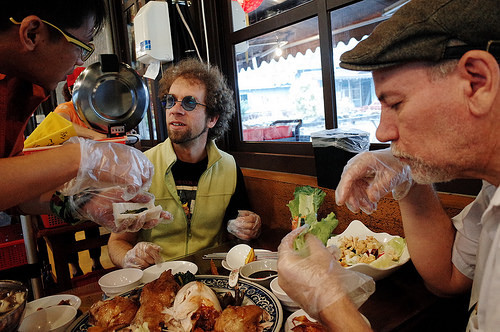 Lunch at Old Mama's. Photo: Li Cheng-shuChicken, piping hot with crispy skin, a basket filled with salad greens and another with a soft bread. And lastly, a dish filled with a thick, aromatic soy paste. As we pulled apart (literally, with plastic gloves provided) our mountain chicken before wrapping the pieces in first the greens and then the bread before dipping the ad hoc sandwich into the black bean paste, Cheng-shu explained that time itself was Old Mama's key ingredient.
Lunch at Old Mama's. Photo: Li Cheng-shuChicken, piping hot with crispy skin, a basket filled with salad greens and another with a soft bread. And lastly, a dish filled with a thick, aromatic soy paste. As we pulled apart (literally, with plastic gloves provided) our mountain chicken before wrapping the pieces in first the greens and then the bread before dipping the ad hoc sandwich into the black bean paste, Cheng-shu explained that time itself was Old Mama's key ingredient.
 "Time Iteself!" Photo: Li Cheng-shuThe chicken was cooked quickly using the high, dry heat provided by the metal drums up front. And the sauce-Old Mama's secret recipe-had been aging and fermenting for six months in the clay pots on the side of the building.
"Time Iteself!" Photo: Li Cheng-shuThe chicken was cooked quickly using the high, dry heat provided by the metal drums up front. And the sauce-Old Mama's secret recipe-had been aging and fermenting for six months in the clay pots on the side of the building.
My first home style Taiwanese meal in three years did not disappoint.
After lunch, we headed to the Jhentoushan Agricultural Leisure Area , a collection of attractions just a few kilometers to the west of Yilan city, driving along roads flanked by rice paddies and cloud-shrouded mountains.
We stopped at Jung Lung Jai, an old farmhouse reincarnated into a rustic café serving coffee, kumquat tea and freshly baked goods. In many ways the café represented the changes that have taken place in some parts of Yilan as places like JALA have widened their focus to incorporate leisure activities into traditional agricultural life.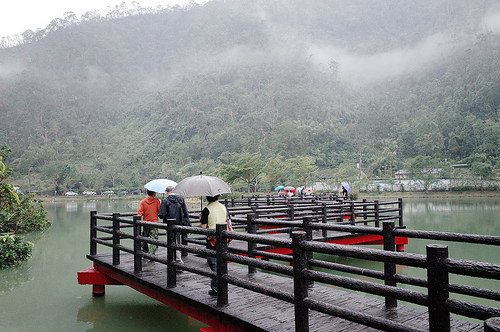 Dragon Watching Pond. Photo: Li Cheng-shuAfter an iced cappuccino, we walked to Wang Long Hu, or Dragon Watching Pond, an artificial lake with a multi-angled bridge leading to an island in the center. But there were no dragons to watch, only cormorants, clouds and a few fellow travelers enjoying the moody ambiance.
Dragon Watching Pond. Photo: Li Cheng-shuAfter an iced cappuccino, we walked to Wang Long Hu, or Dragon Watching Pond, an artificial lake with a multi-angled bridge leading to an island in the center. But there were no dragons to watch, only cormorants, clouds and a few fellow travelers enjoying the moody ambiance.
The rain was coming down steadily now, dashing our hiking plans. Cheng-shu drove us instead to another of JALA's attractions, a small plot of land with a dozen or so beehives. We knocked on the door of a nearby house, and after a few minutes an old man tottered out. Old Zhang told us he'd spent the better part of eight decades bringing his hives to pollinate the pomelos, kumquats and other assorted fruits of the area, and while age had slowed him down physically, age wasn't solely responsible for his diminished hives.
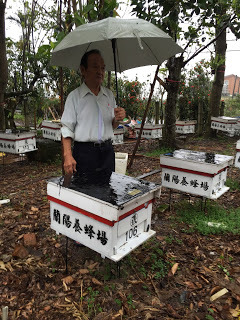 Mr. Zhang. Photo: Josambro"These are a fraction of what I used to have," Zhang told us. "A few years back they started dying out, some disease from America…."The rain drove Zhang back into his house, and us back into Cheng-shu's car. We headed to another of JALA's attractions, Bo Zen Farm. Exiting the car, we were greeted by a tall and strangely inquisitive white goose who seemed intent on corralling us across the short and muddy field. Inside a large greenhouse on the other side we found Mrs. Chen tending thousands of pitcher plants, Venus flytraps and other carnivorous foliage that are Bo Zen Farm's agricultural output.
Mr. Zhang. Photo: Josambro"These are a fraction of what I used to have," Zhang told us. "A few years back they started dying out, some disease from America…."The rain drove Zhang back into his house, and us back into Cheng-shu's car. We headed to another of JALA's attractions, Bo Zen Farm. Exiting the car, we were greeted by a tall and strangely inquisitive white goose who seemed intent on corralling us across the short and muddy field. Inside a large greenhouse on the other side we found Mrs. Chen tending thousands of pitcher plants, Venus flytraps and other carnivorous foliage that are Bo Zen Farm's agricultural output.
 Bo Zen Farm. Photo: Li Cheng-shu
Bo Zen Farm. Photo: Li Cheng-shu
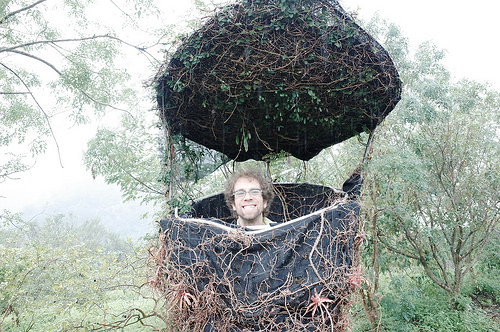 Loco Mosquito. Photo: Lin Cheng-shuHanding me some dried corn to bribe the goose, Mrs. Chen explained that Bo Zen grows carnivorous plants sold throughout Taiwan, also doubling as a tourist attraction. To drive this home, she had me climb inside a man-sized plaster pitcher plant sculpture for a photograph.
Loco Mosquito. Photo: Lin Cheng-shuHanding me some dried corn to bribe the goose, Mrs. Chen explained that Bo Zen grows carnivorous plants sold throughout Taiwan, also doubling as a tourist attraction. To drive this home, she had me climb inside a man-sized plaster pitcher plant sculpture for a photograph.
Our last stop in JALA was the Agrioz museum of Candied Fruit.
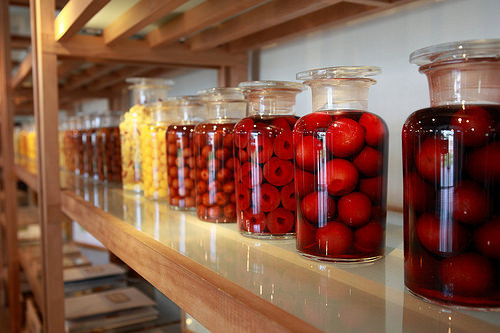 Agrioz Display. Photo: Li Cheng-shuIt was somewhat more popular, judging by the number of tour buses. Part factory, part store, Agrioz earns the right to call itself a museum thanks to the educational tours, complete with courses in DIY candied fruit-making. We declined the course, but accepted several candied fruit samples and a serenading in Taiwanese by second-generation candied fruit maker and Agroz manager Lin Ding-gang.
Agrioz Display. Photo: Li Cheng-shuIt was somewhat more popular, judging by the number of tour buses. Part factory, part store, Agrioz earns the right to call itself a museum thanks to the educational tours, complete with courses in DIY candied fruit-making. We declined the course, but accepted several candied fruit samples and a serenading in Taiwanese by second-generation candied fruit maker and Agroz manager Lin Ding-gang.
With jet lag closing in, Cheng-shu drove us back to Jiaoshi, where Tobie and I headed to the Art Spa - about which much has already been written, some of it by me. After soaking for an hour (the hot spring fed water slide was, alas, closed), we went in search of seafood in the rain before heading to the hotel to crash.
 Lunch at Old Mama's. Photo: Li Cheng-shuChicken, piping hot with crispy skin, a basket filled with salad greens and another with a soft bread. And lastly, a dish filled with a thick, aromatic soy paste. As we pulled apart (literally, with plastic gloves provided) our mountain chicken before wrapping the pieces in first the greens and then the bread before dipping the ad hoc sandwich into the black bean paste, Cheng-shu explained that time itself was Old Mama's key ingredient.
Lunch at Old Mama's. Photo: Li Cheng-shuChicken, piping hot with crispy skin, a basket filled with salad greens and another with a soft bread. And lastly, a dish filled with a thick, aromatic soy paste. As we pulled apart (literally, with plastic gloves provided) our mountain chicken before wrapping the pieces in first the greens and then the bread before dipping the ad hoc sandwich into the black bean paste, Cheng-shu explained that time itself was Old Mama's key ingredient.
 "Time Iteself!" Photo: Li Cheng-shuThe chicken was cooked quickly using the high, dry heat provided by the metal drums up front. And the sauce-Old Mama's secret recipe-had been aging and fermenting for six months in the clay pots on the side of the building.
"Time Iteself!" Photo: Li Cheng-shuThe chicken was cooked quickly using the high, dry heat provided by the metal drums up front. And the sauce-Old Mama's secret recipe-had been aging and fermenting for six months in the clay pots on the side of the building.My first home style Taiwanese meal in three years did not disappoint.
After lunch, we headed to the Jhentoushan Agricultural Leisure Area , a collection of attractions just a few kilometers to the west of Yilan city, driving along roads flanked by rice paddies and cloud-shrouded mountains.
We stopped at Jung Lung Jai, an old farmhouse reincarnated into a rustic café serving coffee, kumquat tea and freshly baked goods. In many ways the café represented the changes that have taken place in some parts of Yilan as places like JALA have widened their focus to incorporate leisure activities into traditional agricultural life.
 Dragon Watching Pond. Photo: Li Cheng-shuAfter an iced cappuccino, we walked to Wang Long Hu, or Dragon Watching Pond, an artificial lake with a multi-angled bridge leading to an island in the center. But there were no dragons to watch, only cormorants, clouds and a few fellow travelers enjoying the moody ambiance.
Dragon Watching Pond. Photo: Li Cheng-shuAfter an iced cappuccino, we walked to Wang Long Hu, or Dragon Watching Pond, an artificial lake with a multi-angled bridge leading to an island in the center. But there were no dragons to watch, only cormorants, clouds and a few fellow travelers enjoying the moody ambiance. The rain was coming down steadily now, dashing our hiking plans. Cheng-shu drove us instead to another of JALA's attractions, a small plot of land with a dozen or so beehives. We knocked on the door of a nearby house, and after a few minutes an old man tottered out. Old Zhang told us he'd spent the better part of eight decades bringing his hives to pollinate the pomelos, kumquats and other assorted fruits of the area, and while age had slowed him down physically, age wasn't solely responsible for his diminished hives.
 Mr. Zhang. Photo: Josambro"These are a fraction of what I used to have," Zhang told us. "A few years back they started dying out, some disease from America…."The rain drove Zhang back into his house, and us back into Cheng-shu's car. We headed to another of JALA's attractions, Bo Zen Farm. Exiting the car, we were greeted by a tall and strangely inquisitive white goose who seemed intent on corralling us across the short and muddy field. Inside a large greenhouse on the other side we found Mrs. Chen tending thousands of pitcher plants, Venus flytraps and other carnivorous foliage that are Bo Zen Farm's agricultural output.
Mr. Zhang. Photo: Josambro"These are a fraction of what I used to have," Zhang told us. "A few years back they started dying out, some disease from America…."The rain drove Zhang back into his house, and us back into Cheng-shu's car. We headed to another of JALA's attractions, Bo Zen Farm. Exiting the car, we were greeted by a tall and strangely inquisitive white goose who seemed intent on corralling us across the short and muddy field. Inside a large greenhouse on the other side we found Mrs. Chen tending thousands of pitcher plants, Venus flytraps and other carnivorous foliage that are Bo Zen Farm's agricultural output.  Bo Zen Farm. Photo: Li Cheng-shu
Bo Zen Farm. Photo: Li Cheng-shu
 Loco Mosquito. Photo: Lin Cheng-shuHanding me some dried corn to bribe the goose, Mrs. Chen explained that Bo Zen grows carnivorous plants sold throughout Taiwan, also doubling as a tourist attraction. To drive this home, she had me climb inside a man-sized plaster pitcher plant sculpture for a photograph.
Loco Mosquito. Photo: Lin Cheng-shuHanding me some dried corn to bribe the goose, Mrs. Chen explained that Bo Zen grows carnivorous plants sold throughout Taiwan, also doubling as a tourist attraction. To drive this home, she had me climb inside a man-sized plaster pitcher plant sculpture for a photograph. Our last stop in JALA was the Agrioz museum of Candied Fruit.
 Agrioz Display. Photo: Li Cheng-shuIt was somewhat more popular, judging by the number of tour buses. Part factory, part store, Agrioz earns the right to call itself a museum thanks to the educational tours, complete with courses in DIY candied fruit-making. We declined the course, but accepted several candied fruit samples and a serenading in Taiwanese by second-generation candied fruit maker and Agroz manager Lin Ding-gang.
Agrioz Display. Photo: Li Cheng-shuIt was somewhat more popular, judging by the number of tour buses. Part factory, part store, Agrioz earns the right to call itself a museum thanks to the educational tours, complete with courses in DIY candied fruit-making. We declined the course, but accepted several candied fruit samples and a serenading in Taiwanese by second-generation candied fruit maker and Agroz manager Lin Ding-gang. With jet lag closing in, Cheng-shu drove us back to Jiaoshi, where Tobie and I headed to the Art Spa - about which much has already been written, some of it by me. After soaking for an hour (the hot spring fed water slide was, alas, closed), we went in search of seafood in the rain before heading to the hotel to crash.
Published on November 23, 2015 16:22
No comments have been added yet.



